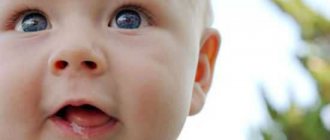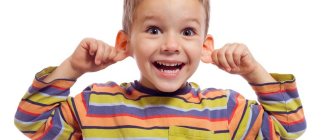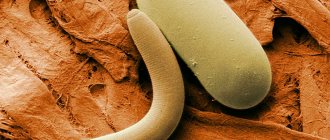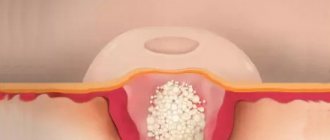A child with Down syndrome and its characteristics
The birth of a baby with Down syndrome, as with any other developmental disorder, is always associated with worries and fears. This event usually gives rise to many questions related to the urgent need to receive reliable information about how to live further, how to provide the baby with the necessary care and development, who can help, advise, advise, tell, share their own experience...
WHAT IS DOWN SYNDROME
Down syndrome was first described in 1866 by British scientist John Langdon Down, and its chromosomal origin was substantiated in 1959.
According to statistics, one child out of 700-800 newborns is born with Down syndrome. This ratio is the same in different countries, climate zones, and social strata. It does not depend on the parents’ lifestyle, their health, age, bad habits, nutrition, wealth, education, skin color or nationality. Boys and girls are born at the same frequency. The parents have a normal set of chromosomes.
CAUSE OF DOWN SYNDROME
Each cell of an ordinary person's body contains 46 chromosomes, making up 23 pairs. The process of formation of germ cells containing 23 chromosomes is called meiosis.
The human body is extremely complex, and when a new life is born, deviations sometimes occur during the process of meiosis. If the chromosome set of the fetus differs from normal, this entails certain consequences. For example, a fertilized cell contains not 46, but 47 chromosomes. In this case, during the process of meiosis, one of the paternal or maternal chromosomes - the twenty-first - formed a so-called trisomic zygote, and trisomy -21 arose, that is, Down syndrome.
BABY WITH DOWN SYNDROME
It is impossible to predict exactly what a child will be like when he grows up. This applies equally to any newborn, including a baby with Down syndrome. It is important to remember that such a baby, despite certain characteristics, will develop, begin to coo and laugh, crawl and walk, communicate with his parents and other people, express joy and sadness. He will learn to eat and drink, wash and go to the toilet, dress and undress, help around the house, protect himself and take care of others, and find friends and hobbies. It is very important that children with Down syndrome attend kindergarten and then school. And recent years have been characterized by the fact that children have this opportunity.
The presence of an extra chromosome causes a number of specific features that are common to most people with Down syndrome.
I would like to draw the attention of parents to certain aspects of the growth and development of a child with Down syndrome, since some features and problems can go unnoticed for quite a long time and have a negative impact on the development of the baby. Knowing about such “weak points,” parents can keep them under control and promptly seek help from specialists, creating conditions to prevent their consequences.
Features of the structure of the head, face and body:
The head of children with Down syndrome may be somewhat flattened at the back . Somewhat later than in other babies, the fontanel may close. Later closure of the fontanel does not require any additional measures.
The nasal passages can be narrow, so they are often clogged with mucus, and then the child breathes with his mouth slightly open. With such breathing, the mucous membrane of the mouth and lips dries and the risk of new respiratory diseases increases. It is very important to ensure that your child's nose is free of mucus and to encourage your child to breathe correctly from a very early age. You can help this by rinsing your nose with a pipette or syringe without a needle, filling them with saline or boiled water with the addition of salt at the rate of 1 tsp. salt per liter of water.
A small mouth , a high and narrow palate, a relatively large tongue , and decreased tone of the muscles of the face and mouth lead to children sticking out their tongue. There are simple measures that can help eliminate this feature by teaching the child to keep his tongue in the mouth.
For this purpose, the following methods and techniques are used:
- Massage of facial and oral muscles
- Proper organization of feeding: sucking – strengthens the orbicularis muscle of the mouth and tongue; biting – teaches the child to put his tongue in his mouth; Chewing food creates lateral movements of the tongue (as opposed to back and forth movements, as happens when sucking). Proper use of a spoon allows you to push your tongue into your mouth, and drinking from a cup teaches you to close your mouth and swallow saliva.
Arms and legs
A baby with Down syndrome may have slightly shorter limbs than a typical baby. The fingers and toes are also shorter. The palms are quite wide, often crossed by solid transverse lines-folds, the little fingers on the hands may be slightly curved. All these features are successfully compensated for by special classes for the development of fine motor skills.
Height
Newborn babies with Down syndrome are slightly smaller than normal babies, and the growth curves for normal children that are used in our clinics do not fit them. A child with Down syndrome grows and gains weight somewhat differently. Growth rate varies depending on age.
Decreased muscle tone and excessively mobile joints
Almost all children with Down syndrome have reduced muscle tone. In medicine, this phenomenon is called hypotension. With hypotension, the muscles are relaxed, and it is more difficult for the child to move actively, so it is very important to take the child in your arms, give him maternal massage, and play outdoor games. The so-called active type gymnastics is very effective, when the child himself is active, and not a specialist. Special gymnastics (kinesiotherapy) for children with Down syndrome was developed by the Dutch physiotherapist and author of a method for promoting the motor development of children with Down syndrome, Peter Lauteslager. With regular exercise that stimulates motor development, hypotension is compensated with age by developing balance and strengthening muscles.
MEDICAL PROBLEMS
Not everything listed below is necessarily true for every child with Down syndrome. But the occurrence of such problems is possible, and parents need to ensure that the child is regularly examined.
Vision
With Down syndrome, there are a number of ophthalmological problems that require treatment and correction.
The structural features of the tear ducts can sometimes lead to conjunctivitis and lacrimation. Conservative therapy in these cases, as a rule, consists of massage of the nasolacrimal sac and treatment of conjunctivitis with local antibiotics.
Strabismus is quite common. Due to hypotonia of the eye muscles, it takes them longer to learn to coordinate eye movements. This process can be accelerated by doing special exercises with your baby, which an ophthalmologist or special teacher will tell you about.
Myopia and farsightedness, which are quite traditional for our society, also do not bypass children with Down syndrome. These visual distortions can be corrected with glasses.
Sometimes babies with Down syndrome develop other eye diseases, so they need regular monitoring by a specialist.
Hearing
Children with Down syndrome may have decreased hearing. This may be due to ear infections, but congenital hearing loss is also possible. In about a third of cases, hearing loss is minor and does not require special medical measures, but you should definitely know about such hearing loss! From the first year of a baby’s life, it is necessary to regularly monitor the condition of his hearing, since missed problems can negatively affect the overall development, in particular, the development of speech. There are simple ways that allow parents to conduct an initial examination. If your concerns are confirmed, you should seek professional help.
If treatment is necessary, it must be carried out. Medical prescriptions in these cases are practically the same as for ordinary children.
Obstructive sleep apnea syndrome
The structure of the upper respiratory tract in Down syndrome is characterized by narrowing of the nasopharynx and oropharynx, Eustachian tubes, and external auditory canals. During sleep, the child's muscles relax, and the access of air to the oropharynx may be partially or completely blocked by the root of the tongue. In this case, the child snores, breathes intermittently, often wakes up or takes a specific position in his sleep (the head is noticeably thrown back, older children can sleep sitting up). This phenomenon is called apnea. The presence of sleep apnea leads to lethargy and drowsiness during the day, a decrease in the rate of physical development and deterioration in behavior, frequent crying and restlessness. To prevent apnea, it is necessary to raise the head end of the crib by 10 degrees and, if possible, lay the baby on its side. In some cases, it is necessary to remove the child's tonsils or carry out other medical measures.
Leather
The skin of babies with Down syndrome is less elastic, drier and rougher. Among these children, exudative diathesis is not uncommon, and the skin is more susceptible to cracks.
To increase blood circulation, and therefore “revitalize” the baby’s skin, it is good to use “maternal massage”, which an early development specialist can tell you about, as well as stir the baby, turn him from side to side, bathe him regularly, using special oils. (vaseline, peach, etc.).
Teeth
In general, baby teeth in children with Down syndrome last quite a long time, so they “wear out” more. Due to the reduced tone of the tongue, children find it more difficult to chew, and food debris is less easily removed from the teeth. Giving your child some plain water after each meal will help wash away any remaining food.
By the way, children with Down syndrome often grind their teeth, and parents should keep in mind that such grinding has nothing to do with the presence of helminthiasis (the presence of worms).
To prevent dental diseases, it is necessary to pay due attention to the child’s oral hygiene and, of course, regularly visit the dentist.
Thyroid
Some children with Down syndrome have an imbalance of hormones produced by the thyroid gland.
There are certain signs that suggest that the thyroid gland is not functioning properly. These include:
- weight gain in the absence of height gain;
- lethargy, lethargy, noticeable decrease in reaction speed;
- loss of appetite, constant constipation;
- hoarseness, thinning and brittle hair, dry and flaky skin.
Digestive organs
Most babies with Down syndrome have normal digestive organs, but sometimes problems in this area still occur, and this requires seeing a doctor.
Hypotension of the intestinal tract can cause constipation. As the child grows up and begins to move more, muscle tone gradually increases, and these types of problems are resolved naturally.
In case of more serious violations, the necessary medical assistance is provided in the same way as with all children.
Heart
Unfortunately, cardiac dysfunction in Down syndrome is not uncommon, and about 30–40% of children with the syndrome suffer from some kind of abnormality in this area.
The severity of heart abnormalities ranges from minor heart failure that resolves over time to very serious, life-threatening heart defects that require surgery, sometimes immediate.
Signs of heart failure include pale grayish or bluish skin, difficulty breathing, swelling of the eyelids, and a heart murmur heard by the doctor when listening. However, the clinical picture can be blurry, so children with Down syndrome in the first days of life need a careful examination by a cardiologist, as well as an ECG and EchoCG examination. If abnormalities in cardiac activity are detected that do not require surgery, children still need regular scheduled examinations by a specialist.
Musculoskeletal system
Muscular hypotonia and excessive elasticity of connective tissues predispose to orthopedic problems such as hip dysplasia, dislocations or subluxations of the hips, instability of the patella, scoliosis, and flat feet. Therefore, a child with Down syndrome needs to be examined by an orthopedist and a control X-ray of the hip joints. Currently, this type of examination is carried out on almost all children. Choosing the right shoes is very important.
The motor development of children with the syndrome is somewhat slower; it is more difficult for them to master coordinated body movements. It is very important to ensure that your baby regularly gains motor experience. The latest recommendations suggest maternal massage and active gymnastics.
Organization of feeding
Infants with Down syndrome, like all children, are advised to breastfeed.
Despite some structural features of the maxillofacial apparatus and reduced tone, breastfeeding is possible, like with all babies. Breastfeeding not only provides the baby with the best nutrition, but also strengthens the immune system, prevents ear infections and develops the muscles of the face and mouth.
In addition, breastfeeding helps the mother establish very good emotional contact with the baby. Time and effort aimed at helping your baby learn to suck will certainly not be in vain
Proper introduction of solid food helps stimulate the child’s articulation organs, which means it has a positive effect on speech development. You can read about how to help a child with Down syndrome learn to chew and eat with a spoon here.
You should be careful about possible allergic reactions of a baby with Down syndrome to certain foods, especially cow's milk, honey and wheat.
MEDICAL CARE and MEDICAL EXAMINATION SCHEDULE
Children with Down syndrome are more susceptible to certain diseases than normal children, so it is important for parents to maintain contact with the pediatrician and other medical specialists for timely examination of the child and his treatment, if necessary. Unfortunately, not all pediatricians and other specialists in outpatient departments are sufficiently familiar with the developmental characteristics of children with Down syndrome, so it is useful for parents to have an idea of the examinations their child needs in order to correctly navigate the doctor’s prescriptions.
Many of the medical tests listed here are common to all babies, but they are especially necessary for a child with Down syndrome.
We provide a table that will help you organize the necessary medical examinations of your baby in a timely manner. We recommend that you print out this table in two copies, keep one of them for yourself, and give the second to your pediatrician to paste into your child’s chart.
SPECIFIC MEDICAL MEASURESAt this level of medical development, we have not yet learned how to treat a deviation in the chromosome set. It is quite natural that the parents of a child with Down syndrome do their best to help him, so it seems appropriate to us to dwell very briefly on some types of special medical measures that are taken in world practice. Medical stimulation of people with Down syndrome is a controversial issue. There are still no methods that are reliably useful and do not cause harm; here are some examples: Cell therapy. In the 1960s, special studies of this method were carried out, during which it became clear that the effectiveness of cell therapy does not have convincing evidence and that its use increases the risk of allergic and shock reactions, as well as the risk of transmitting inactive viruses. In the late 1980s, in Germany, for example, this therapy was prohibited by law. Vitamins, minerals and other compounds Down syndrome has been repeatedly treated with various combinations of vitamins, minerals, hormones and enzymes, as well as with what are now called nutritional supplements. Studies conducted in the 1980s of the twentieth century did not reveal a noticeable positive effect of such therapy. And although children with Down syndrome, like all other children, need vitamins, minerals and other elements, experience shows that extremely high doses of these compounds do not contribute to either improving the mental state of children with this syndrome or the functioning of other body systems. PSYCHOLOGICAL AND PEDAGOGICAL ASSISTANCEThe development of a child largely depends on how and in what time conditions were created that were optimal for the formation of skills. Currently, in addition to methods and development programs developed by foreign specialists, DSA specialists have adapted and developed methods that take into account foreign and domestic experience. The basic principles underlying these programs are as follows:
Directions of development The need for an early start of psychological and pedagogical assistance for children with special needs is now recognized by the majority of researchers and specialists. And this is due not only to common sense (“the sooner the better”), but also to the significant positive experience of early intervention services abroad and in our country. From the first weeks of a child’s life, specialists pay special attention to the following aspects of development:
Drawing up a lesson program. Based on observations of the baby and conversations with parents, specialists create an individual program of activities for him, which can be implemented at home. The implementation of this program by parents and its inclusion in everyday life help children achieve good results both in learning and in social adaptation. Parents themselves can observe the dynamics of development. For almost two decades, the Family Support Center, created under the Downside Up Charitable Foundation, has been working in this direction, which has developed an integrated approach to child development. The Downside Up Family Support Center provides free psychological and pedagogical assistance to families raising children with Down syndrome aged from birth to 7 years. When contacting the Center, parents can receive help from a psychologist and special teachers. They have the opportunity to directly participate in the child’s pedagogical examination and discuss with specialists issues related to his development and learning. X X X Every parent wants to do as much as possible for their child. When a baby is born with Down syndrome, parents and loved ones strive to use all means available to them to help him. Downside Up's extensive experience of working with families raising children with Down syndrome allows us to draw your attention, dear parents, to the need for close attention not only to the child's health, but also to activities aimed at teaching your child motor and communication skills and developing his cognitive activity, speech and many different skills and abilities necessary for everyday life at home and in the big world! Please remember that most of all the baby needs your company, your joy and love, sincere and reasonable care and help, acceptance and participation! |
Help your child
The mosaic version of DM, despite its milder course, requires constant work with such children. Unfortunately, it is impossible to completely get rid of the pathology, but with the help of multidisciplinary therapy, you can help the child better adapt to society and not feel deprived.
It is very important for children with Down syndrome to undergo massage and physical therapy. They will increase muscle tone and strengthen them, eliminate contractures, stabilize the functioning of joints and the entire musculoskeletal system.
Massage is indicated from 2 weeks of birth. But not all techniques can be used at this age. Kneading is not used for children under 3 months. If your baby has heart problems, you should consult your doctor about massage techniques.
Among the physical therapy methods, be sure to use ball exercises. Thanks to them, motor reflexes and coordination develop.
Swimming lessons are indicated for children with diabetes. It performs the function of hydromassage.
Particularly highlighted are such treatment methods as hippotherapy and dolphin therapy.
Hippotherapy is a therapeutic effect achieved through communication with horses. This method provides:
- development of balance and attention;
- gives self-confidence;
- the warmth that comes from the horse calms the child and gives him a feeling of security.
This is an excellent method for balancing the nervous system of people with any type of Down syndrome. But it requires certain conditions to be met:
- It is important that the horse is big, not a pony. They are overly fussy.
- Before you mount a horse, you need to establish contact with it: talk, feed, pet it.
- The animal must be without a saddle or horseshoes.
- It is not recommended to ride on asphalt.
Dolphin therapy provides relaxation and improved mood, gives self-confidence, and helps to acquire communication skills. This method also stimulates physical development. The ultrasound produced by dolphins restores normal biocurrents.
Other methods of therapy include:
- prescription of medications - hormones, psychostimulants, neurometabolites, vitamin complexes;
- consultations with a psychologist and psychotherapist;
- diet therapy - often such patients suffer from obesity, which can lead to other pathologies. Therefore, you should follow a proper nutrition system to prevent excessive weight gain;
- constant supervision by specialized specialists.
EXTERNAL SIGNS OF MOSAIC SYNDROME
As already mentioned, people with a similar form of the disease may not differ much in development and appearance from their peers. Among them there are even very attractive children and adults.
Although, on the other hand, many carriers of this defect have the same symptoms as with the common trisomy.
Children with mosaic Down syndrome are often short in stature and growth occurs very slowly. The limbs are disproportionate to the body and are reduced in size.
In 90% of cases, such people have a flat face and brachycephaly - a shortened skull with a flat back of the head. The neck is usually short with a thickened skin fold. A similar sign is noticeable already in the neonatal period.
Characteristic facial features in people with a similar defect are a flat bridge of the nose and a small nose; in 30% of cases, strabismus (squint) may develop.
The most striking manifestation of Down syndrome, which accompanies all its forms, is epicanthus. This concept refers to a fold of skin that hangs slightly over the inner edge of the eye. Because of this feature, Down people resemble representatives of the Mongoloid race. And that is why the discoverer of the defect initially called it Mongolism, and the patients - Mongoloids.
Other facial features include a distorted arched palate and abnormal teeth. These defects and muscle hypotonia make it difficult to close the mouth, so it is always half open. The tongue in children with the mosaic form of the syndrome is grooved. Together with the gothic palate, they make sucking difficult, which is why such a child does not gain weight well. However, for a mild degree of the disease, which is mosaicism, this is not always typical.
Brushfield pigment spots may be present on the iris and around its circumference. Another feature is abnormal ears, which are located below the eye line. They are deformed, often protrude and can cause hearing problems.
Anomalies also affect the musculoskeletal system. They are manifested by joint lability and bone deformation. For example, the sternum has a keeled shape. The pathognomonic symptom is clinodactyly or curvature of the little finger. The ribs and spine are also deformed. This is due to underdevelopment of bone tissue.
The appearance of excess skin folds is a common sign of downism. They are formed due to underdevelopment of bones, so the skin between them does not stretch well. In addition to the neck, folds across the palm and in the elbow are also characteristic.
External deformations often cause disturbances in the functioning of internal organs. Irregular bone shape, muscle hypotonia and other features lead to the following internal pathologies:
- abnormalities in the development of blood vessels and the heart;
- problems with vision and hearing;
- digestive system disorders;
- underdevelopment of the kidneys;
- hypothyroidism
Let us note once again that down people with the mosaic variant do not always have all the symptoms combined. Many of them do not appear, making it difficult to recognize the disease.
PSYCHOMOTOR DEVELOPMENT
Teaching people with Down syndrome is a very rewarding endeavor. Every achievement brings them extremely much joy. They approach this process with great enthusiasm and put in a lot of effort.
From a very early age, people with diabetes require close attention and careful work with them. Children with a mosaic form are close to normal in their development, but still have some features that need to be corrected.
It should be understood that the thinking of such children is slightly different. It is more inert, often it is difficult for such a baby to concentrate, he lacks perseverance. Therefore, the process of teaching them needs to be approached creatively, preferably in a playful way.
New information should be presented to them in short phrases, repeating them several times, since short-term memory is not sufficiently developed. But the main thing is to do it in an interesting and exciting way. Keep in mind that such students get tired faster than others, so you should take breaks during classes and alternate mental activity with physical activity.
Problems with hearing and vision also reduce the ability to perceive information and slow down the learning process. This should also be taken into account and classes should be adjusted to these features.
You should pay attention to the development of figurative and abstract thinking: clarification of statements and concepts, presentation of evidence, arrangement of objects in space, their classification, etc.
Speech in children with diabetes may be slurred and poor. This problem requires sessions with a speech therapist. This will allow the speech to be delivered correctly and make it more accessible to understanding.
It is important to develop motor skills, because it allows children to take care of themselves in everyday life. Muscle weakness reduces the ability to manipulate the palm and fingers. They should be developed. For example, you can use an exercise in which the hand is fixed on the surface of the table on the edge of the palm. In this case, drawing is performed with 3 fingers, excluding the little finger and ring finger.
You can develop brushes using various techniques:
- clench your fists, imitate a tweezer grip and in the form of a pinch. Alternately touch the thumb with all fingers;
- drawing, including finger drawing, in different planes - strictly horizontal or vertical, at an acute or obtuse angle;
- modeling from any material - plasticine, clay, dough;
- play okay;
- newspaper rip;
- turning the pages of a book;
- using improvised means - arranging buttons into different categories, collecting them on a thread, making jewelry. You can sort and pour cereals. But moderation is important here so as not to tire the little student. Manipulations with jars and lids are also applicable;
- folding mosaics and puzzles. But you should select objects suitable for the child’s age so that he can assemble them on his own;
- working with scissors, laying out appliqués. Creation of patterns;
- teach your child how to dress independently, how to handle laces, zippers, and buttons. You can train him with a doll.
By working with children in this way, you can not only teach them physical skills - it provides direct communication with the baby, stimulates his mental and mental development.
There are special methods that provide direction in teaching children with disabilities:
- Zaitsev's method. The author has developed special cubes, tables and musical accompaniment, which are designed to teach reading skills. This, in turn, affects the quality of writing in the future and smoothes out intellectual problems.
- Montessori method. Its essence is to create an environment in which the child will study at his own request. He chooses his own occupation from the offered range. As a rule, training is conducted in a playful way.
- The Nikitin method is ease and freedom in learning, a relaxed atmosphere. The emphasis is on physical development and hardening. All play equipment must have an educational basis.
- Glen Doman's method is to start learning from a very early age. Already from the age of 1 year, develop speech, teach the basics of counting and reading.
- Cecile Lupan's method is to present information to the child in such a way as to interest him, so that he himself strives to learn. To do this, constantly offer something new, gradually stimulating him and expanding his knowledge himself. The main criteria are curiosity and independence.
Collective activities are very important, in which children reach out and focus on each other.









